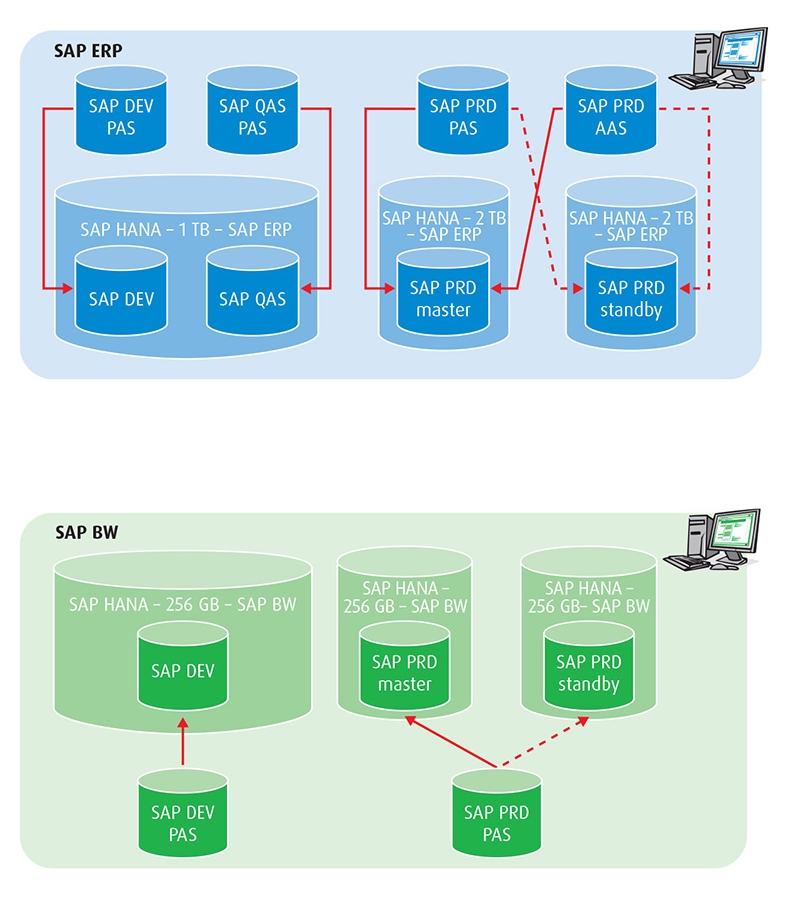In September 2013, the SAP ERP and SAP BW upgrade and migration project was inaugurated in the Sokołów Group. The upgrade and migration of the SAP BW data warehouse system ended in December and of the SAP ERP system in June 2014 (the longer project duration was due to a significantly larger scope of necessary tests and lack of possibility to freeze other changes in the system for the project duration).
It was the first project of migrating SAP ERP to SAP HANA in Poland and one of the first in Europe. Major challenges had to be met, and new quality and project procedures had to be created. In this article, we will focus on the description of experiences from the technical perspective.
– Increased performance and efficiency of business processes based on IT infrastructure
– Use of analytical tools for processing large amounts of data to support decision-making on key areas of the company
– Elimination of user downtimes while waiting for results from SAP applications
– Reduction of infrastructure complexity with the use of new technologies
– Ensuring the required system performance
– Optimization of server infrastructure maintenance cost
In parallel with the migration of SAP BW and ERP to SAP HANA in Sokołów, a project of withdrawal from the IBM i7 platform was carried out. Other systems: SAP PI and SAP Portal were virtualized and run on Linux and Sybase database. The whole project work was divided into the following phases:
- planning and preparation phase
- SAP ERP and BW upgrade
- SAP ERP and BW migration to SAP HANA
- verification and monitoring of systems after migration
The main contractor in the migration was BCC. Due to the innovative nature of the ERP system migration project, the support of SAP consultants from both the Polish branch and headquarters in Walldorf was ensured.
During the project preparation and implementation of specific tasks, the IT staff of Sokolow were actively involved, being responsible among others for coordination with the partner – HP, the provider of the hardware platform for the SAP HANA solution.

Bogdan Biłas, IT Director, Sokołów SA
SAP HANA or miracle diet
By deciding to migrate our SAP systems to the SAP HANA platform, we took some risk to implement a tool which was promising, but new and untested in the market. Our guarantee was that HANA is branded by SAP and supported by BCC (now All for One Poland), a company that is our partner since the implementation of SAP ERP. SAP support, as well as competence and experience of BCC proved to be crucial, especially during hardware sizing, architecture design, and data export and import.
Now we are scooping the bonus for the leader. The use of an innovative in-memory technology allows us to more efficiently and conveniently work with SAP systems we have been using for years. It’s a completely new quality in the use of business applications. Faster transactional processing, instant access to data and reduced system response time we managed to achieve is an important goal in itself. We are happy with the impressive results achieved.
From the perspective of IT infrastructure management in the company, with the migration to the SAP HANA platform we achieved a huge increase in performance while reducing very substantially the cost of software and hardware maintenance. More than four times the data compression decreased the system’s appetite for disk resources. It is a kind of miracle diet that slimmed down the system and let it take on a whole new vigor!
But most of all I want to emphasize that SAP HANA opens up completely new possibilities. Now, when we do not have performance constraints, we can plan new features that were previously beyond the reach of technology. I mean the ability to generate up-to-date reports, even without the use of the data warehouse. SAP HANA performance even makes it possible to transfer a part of analytical processes to a transactional system, which greatly streamlines key processes in the Company, in particular, sales and logistics processes. We have already started this step. Before the migration to HANA, we were afraid to even think about it!
Bogdan Biłas, IT Director, Sokołów SA
Planning and preparation
Due to the nature of the company’s business, SAP solutions used and business objectives, as well as the lack of experience from similar past projects, the planning and preparation phase was given a lot of attention.
In the first step, it was determined that the current version of ERP and BW systems did not allow for their migration to the SAP HANA platform. Prior to the migration, it was necessary to upgrade SAP ERP to 6.0 EHP7 and SAP BW to SAP NetWeaver 7.4.

SAP ERP and BW landscapes after migration to SAP HANA
While defining the upgrade path, it was verified to determine if additional solutions installed could be upgraded to required versions and whether they could cooperate with HANA. For BW systems, the upgrade path for the SEM-BW component was confirmed without problems. In the case of SAP ERP, the situation turned out to be more complex because Sokołów used solutions for electronic document flow from OpenText. After checking SAP Notes and consultations with SAP, the upgrade path was confirmed for this component. Finally, the migration to the SAP HANA platform showed that OpenText operated correctly on the new database solution.
SAP HANA (High Performance ANalytic Appliance), an in-memory data processing technology developed by SAP AG. In contrast to classical relational databases, HANA resides entirely in the server memory. In-memory processing uses large amounts of RAM for data storage, compilation and analysis at any level of detail and aggregation and using any number of dimensions in near-real time. A noticeable increase in performance is guaranteed when processing large data volumes. Disk systems are only used to record the memory state.
Technologies used on SAP HANA databases
– The column-based data layout as the primary way to store application data (in addition to a row-based storage known from traditional databases)
– Table partitioning
– Data compression
– Use of delta for entering new data
Hardware sizing
After the determination of an upgrade vector, hardware sizing for SAP HANA systems started. It is a very important step in applying an in-memory solution. If the required RAM is underestimated, it will not be possible to load all the migrated data, and thus, the systems may not start after the migration.
For SAP BW systems, sizing of the required RAM was carried out based on the /SDF/HANA_BW_SIZING report (the latest available version should be used).
Before the SAP ERP migration project started, the report SDF/HDB_SIZING to support the sizing of required RAM for SAP Business Suite products was not made available yet by SAP. Therefore, the following rule from SAP note was used:
RAM for HANA = size of source system database / 2 + 20%.
The computing power was estimated in the same way as in implementations on any other database based on QuickSizer made available by SAP AG. The required disk space was determined in accordance with the rule specified by the software manufacturer:
disk space for data = 4 x RAM,
disk space for transaction log = 1 x RAM.
Sizing also included virtual application servers to run on newly created virtualization environment. The requirement to create the HA environment for the SAP HANA platform was also taken into account.
As a result of sizing, the report was prepared by BCC containing recommendations for SAP HANA hardware configuration and system landscape after migration. As the HA mechanism for SAP HANA, the database replication functionality available as of SAP HANA 1.0 SPS5 was proposed.
Sokołów used the report as a starting point for the selection of a hardware vendor. Finally, Dell Power Edge 520 (BLADE M100E) and HP ProLiant 980 and HP ProLiant 580 servers were selected as well as integrated systems dedicated for SAP HANA (appliance) based on them, HP Appsystem for SAP HANA.
In the planning phase, the potential impact of migration on reports and extensions from the user namespace was verified. After migration, adjustment of custom applications may be needed to ensure their correct operation. A large number of applications may significantly extend the whole project. The operation of all applications and user extensions should be carefully tested after migration of both the development system and the test system.
The basis for the implementation of SAP HANA in Sokołów was the use of HP Converged System (AppSystem) for SAP HANA. It is a full range of scalable, high-performance, integrated systems, optimized for SAP HANA. They are designed to minimize the complexity and risk by providing a platform in a way that ensures the fastest return on completed implementation projects.
Integrated HP Converged Systems for SAP HANA are based on proven performance components with built-in high availability, characteristic of Mission sCritical systems. The scalability of HP Converged Systems for SAP HANA allows for smooth development with increasing amounts of data.
For the implementation of SAP HANA in Sokołów SA, HP ServiceGuard for Linux & SAP HANA was used. This is a cluster solution, developed in parallel with cluster systems for HP-Ux. The use of this technology allowed us to obtain a level of availability for the whole system defined by IDC as AL 3. That is, the level characteristic of UNIX systems.
As emphasized by Piotr Kurek, EG Regional Sales Manager, HP Poland, “HP is the only SAP technology partner to provide a comprehensive offer for SAP HANA in the market, combining data management systems (backup and snapshot technology) with SAP HANA dedicated consulting and support services for the entire system.”
Jarosław Maślanka, SAP Solution Architect, HP Poland
System upgrade
When planning the migration, the system upgrade to a SAP NetWeaver 7.4-based version providing the latest technology solutions to support SAP HANA.
For SAP BW landscape, both SAP BW and separately installed SAP Portal systems were upgraded, used as a user interface for BI and OpenText solutions.
Solution Manager is required for generating stacks and downloading corrections necessary for an upgrade. Because Solution Manager in the Sokołów environment was used mainly for generating EWA reports, its upgrade was abandoned. As part of the project, the latest system version 7.1 was installed and integrated.
In the customer’s system landscape, in order to generate a relevant stack it was necessary to correctly and precisely define the systems as a product with relevant sets of components. A lot of attention was given to this step because it guaranteed upgrade of all required components, in particular SEM-BW and OpenText. Lack of proper configuration results in the wrong generation of an upgrade vector by Solution Manager, and even makes it impossible to carry out such a process.
After downloading relevant media and corrections, the SAP ERP and BW system upgrade was started. The procedure was carried out in accordance with the methodology recommended by SAP, using the Software Update Manager (SUM) tool and starting from development systems. The migration process of each system ended with a strict verification procedure including technical and application tests. Module consultants and ABAP developers were involved in each upgrade step. Finally, the upgrade was validated by a validation session ordered from SAP AG.
– Upgrade and migration of SAP ERP and BW to the SAP HANA platform
– Migration of production systems with system unavailability not exceeding 72 hours
– Migration of hardware and software platform Virtualization of application servers
Individual system categories: development, test and production were upgraded to newer versions in pairs, in short time intervals. This enabled integration tests, e.g. ERP <-> BW, in the early stages of the project.
Prior to the upgrade of the ERP test system, it was upgraded through a production system copy, which allowed us to precisely determine the duration of individual upgrade phases, and thus to estimate future unavailability of the production system. To minimize the time of unavailability, we used the Near Zero Downtime option. Based on obtained results, we prepared hourly upgrade plans for production ERP and BW systems. In addition, the upgrade of each system was described in detail in the activity report, including the duration of each phase. Descriptions contain information on problems that occurred and how they were resolved. The upgrade procedure of production systems was carried out without problems within the planned time.
Exact technical and application test scenarios created during upgrades of development and test systems were used to verify production systems after upgrade. The upgrade was validated by the customer; systems were made available for end users.
Migration of SAP ERP and BW systems to SAP HANA
The upgrade of SAP ERP and BW systems allowed us to begin the second part of the project – the migration of the environment to the SAP HANA platform.
In accordance with the SAP recommendation, the HANA database should be an independent instance without the SAP application server on the same host. HP provided servers with preinstalled HANA database, based on which two landscapes were configured for ERP and BW systems.
The ERP landscape consisted of one SAP HANA server with 1TB RAM, on which two databases were installed for the ERP development and test systems. The production system consisted of two servers with 2TB RAM, configured for operation as master and standby servers.
The BW landscape was created based on one server with 256 MB RAM for the development system and two servers with 256MB RAM for the production server in a master and standby layout.
– SAP HANA DB
– SAP HANA Studio
– SAP HANA Lifecycle Manager
– SAP Host Agent
Prior to the migration, the provided SAP HANA platform was upgraded to improve its stability, performance and reliability. All components were upgraded to the latest available version 1.68. In addition, the relevant version of migration tools was selected (R3load, R3ldctl, R3szchk). In the case of migration to the SAP HANA platform, using appropriate versions of migration tools for the database version is very important. With the change of a version, the functioning of the tools and frequently the way of responding to errors during export or import also change.
The standard procedure of heterogeneous system copy (with the change of the operating system and database version) was applied. In order to accurately determine the times of unavailability, an additional test migration was performed, without unavailability of the production SAP ERP system. Export without unavailability does not preserve data consistency and may be used only as a test export. However, it allows for a quite precise determination of the time needed to carry out the entire operation.
Each migration of ERP and BW requires certain system-specific preparation steps. For BW systems, activities related to the BW data clean up procedure (data housekeeping) were carried out to reduce the amount of data during exports, and thus shorten the total time of export and import. Similar procedures were used when preparing the ERP system. One of the common steps, regardless of the product, is to run reports verifying cluster tables and recording the required information in the configuration files used by the tool used for migration, Software Provisioning Manager (SWPM), during the import procedure. This step was treated with particular care since SAP HANA platform does not use cluster and pool tables. Migration tools require an appropriate set of information to properly convert these tables to transparent tables.
Because of the relatively large amount of application data, when preparing the system for export, the procedures to split tables into smaller packages and create additional indexes to accelerate export of tables in several threads were started. The procedure significantly reduces the time of the whole process for especially large tables and allows for their later and faster multithreaded import. Conducting the migration procedure of the test and development system first as well as the test migration of the production system helped determine quite accurately the optimal number of required processes.
Before the import, data was transferred to virtual machines prepared earlier for SAP application servers. The export size for the ERP system was ca. 350GB, and for BW ca. 35GB. Data transfer was included in the migration plan due to a significant share in the total duration of the process. As in the case of export, the data import was launched in the SWPM tool.
After migration, the import was validated using the Migration Monitor tool. This tool allows you to determine whether all packages were imported correctly and the number of rows before and after import to SAP HANA.
After validation, a series of post-migration steps specific to the system type were carried out, with particular attention to report RS_BW_POST_MIGRATION, which had to be run in the BW system after migration to the new platform.
The last step was the technical and application test procedure. After final tests were carried out by key users of the customer, the decision to go live with the migrated systems was made.
The whole migration process was carried out correctly and did not exceed the assumed system unavailability window.
Verification and monitoring of systems after migration
During the test migration, several issues with the HANA 1.68 database were observed. Still during the project, the decision to upgrade the databases for BW systems to version 1.72 and ERP systems finally to version 1.74.02 was made. The upgrade significantly improved stability and reliability of the systems.
Furthermore, based on observations of the test ERP system running additionally on a prepared production SAP HANA environment, it was decided to apply reliability solutions. HP ServiceGuard for SAP HANA was implemented as the solution reducing the switching time to a standby server.
The migration project was completed with the Going Live Check session ordered from and conducted by SAP AG.
While testing and monitoring, a substantially improved performance of the systems was observed in relation to the source system performance. User experience and system reliability also improved.
– Higher efficiency of financial and controlling transactions
– Running ad-hoc reports on large data sets
– Compressed data available from the easily manageable reports, allowing for quick decision-making based on the most current data
– Nearly 10-fold data compression, reducing IT requirements
– Simplified database management (no additional indexes and statistics)
Summary
The migration project of SAP ERP and SAP BW to the SAP HANA platform conducted by BCC (now All for One Poland) for Sokolów SA ended with success. Based on gathered experience, we can conclude that careful planning and preparation for migration is a guarantee of successful completion of the project of moving ERP to the HANA platform.
SAP Business Suite on the new database allows using the real-time processing to a greater degree, especially when optimizing accelerators are enabled for each module. Migration of BW systems brings enormous benefits as well, improving the reporting performance, especially when combined with additional analytical tools. Large data volumes are processed in near real time. This allows you to plan the company strategy on the basis of current data analysed in different dimensions.
SAP HANA platform became a ready-to-use and complete product, the implementation of which should be considered when planning new deployment or migration of currently used systems.



